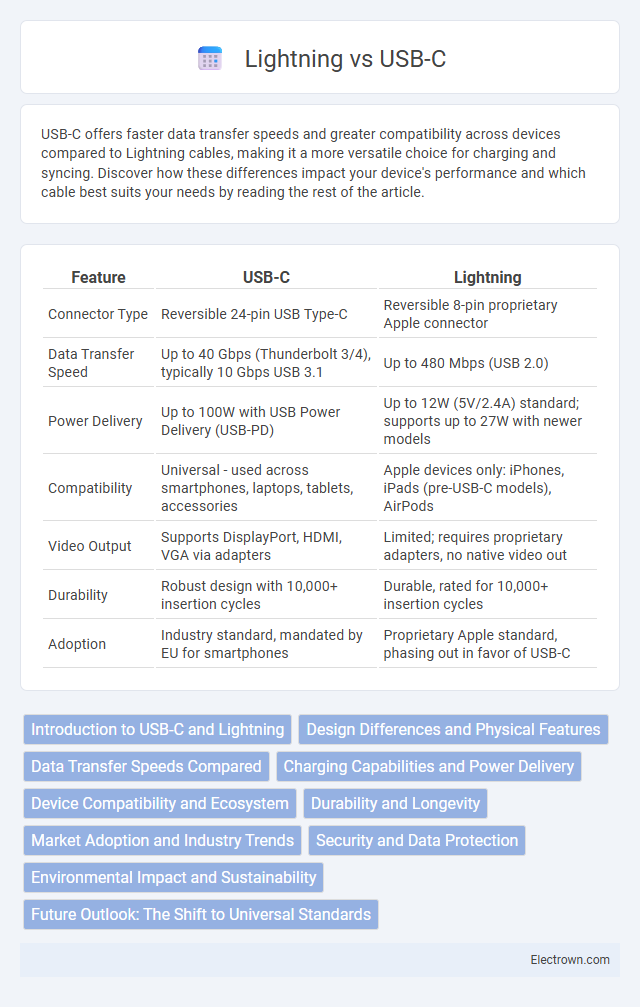USB-C offers faster data transfer speeds and greater compatibility across devices compared to Lightning cables, making it a more versatile choice for charging and syncing. Discover how these differences impact your device's performance and which cable best suits your needs by reading the rest of the article.
Table of Comparison
| Feature | USB-C | Lightning |
|---|---|---|
| Connector Type | Reversible 24-pin USB Type-C | Reversible 8-pin proprietary Apple connector |
| Data Transfer Speed | Up to 40 Gbps (Thunderbolt 3/4), typically 10 Gbps USB 3.1 | Up to 480 Mbps (USB 2.0) |
| Power Delivery | Up to 100W with USB Power Delivery (USB-PD) | Up to 12W (5V/2.4A) standard; supports up to 27W with newer models |
| Compatibility | Universal - used across smartphones, laptops, tablets, accessories | Apple devices only: iPhones, iPads (pre-USB-C models), AirPods |
| Video Output | Supports DisplayPort, HDMI, VGA via adapters | Limited; requires proprietary adapters, no native video out |
| Durability | Robust design with 10,000+ insertion cycles | Durable, rated for 10,000+ insertion cycles |
| Adoption | Industry standard, mandated by EU for smartphones | Proprietary Apple standard, phasing out in favor of USB-C |
Introduction to USB-C and Lightning
USB-C is a versatile, reversible connector standard widely adopted across smartphones, laptops, and other devices, offering fast data transfer rates and power delivery up to 100W. Lightning, developed by Apple, is a proprietary connector primarily used on iPhones, iPads, and accessories, known for its compact design and efficient power management. While USB-C supports universal compatibility and faster performance, Lightning remains prevalent in Apple's ecosystem due to its tailored integration.
Design Differences and Physical Features
USB-C connectors feature a symmetrical, oval shape enabling reversible plug orientation on both ends, measuring approximately 8.4mm by 2.6mm. Lightning connectors are smaller, about 6.7mm by 1.5mm, with an 8-pin design that is reversible but less standardized compared to USB-C. USB-C supports higher durability with robust metal housing, while Lightning connectors often incorporate a plastic exterior with a metal tip for Apple device compatibility.
Data Transfer Speeds Compared
USB-C supports data transfer speeds up to 10 Gbps with USB 3.1 Gen 2 and even higher with USB4 or Thunderbolt 3 standards, making it ideal for fast file transfers and high-resolution video streaming. Lightning connectors, used primarily on Apple devices, max out at USB 2.0 speeds of 480 Mbps, significantly slower than USB-C. This speed difference impacts tasks like backing up large files or transferring high-definition media, favoring USB-C for performance-intensive applications.
Charging Capabilities and Power Delivery
USB-C supports higher power delivery standards, offering up to 100W charging, which enables faster and more efficient charging for a wide range of devices including laptops, tablets, and smartphones. Lightning connectors, typically limited to 12W or 18W charging on Apple devices, deliver slower charging speeds and lower power output compared to USB-C. USB-C's compatibility with the USB Power Delivery (USB-PD) protocol ensures flexible voltage and current levels, optimizing charging performance and supporting rapid charging across diverse gadgets.
Device Compatibility and Ecosystem
USB-C offers broad device compatibility across numerous brands and product categories, including smartphones, laptops, tablets, and peripherals, making it a universal standard for data transfer and charging. Lightning remains exclusive to Apple's ecosystem, supporting iPhones, iPads (excluding recent iPad Pro models), and a range of proprietary accessories, ensuring optimized performance within Apple devices. The extensive support for USB-C in Windows, Android, and macOS devices provides greater versatility, while Lightning's tight integration benefits users fully invested in Apple's ecosystem.
Durability and Longevity
USB-C connectors feature reinforced designs and symmetrical reversible plugs, enhancing durability and reducing wear from frequent use. Lightning cables often have thinner connectors and less robust strain relief, making them more prone to fraying and damage over time. Choosing USB-C for your devices can offer greater longevity and reliability, especially under heavy daily use.
Market Adoption and Industry Trends
USB-C has rapidly become the standard port for most smartphones, laptops, and tablets due to its universal compatibility and faster data transfer speeds, with tech giants like Samsung, Google, and Apple adopting it widely. Apple's transition from Lightning to USB-C on newer iPhone models reflects shifting industry trends towards a unified charging ecosystem and regulatory pressures from regions like the EU. Market adoption favors USB-C as manufacturers prioritize device interoperability, faster charging, and consumer convenience, signaling a gradual phase-out of proprietary connectors like Lightning.
Security and Data Protection
USB-C offers enhanced security features through its support for robust data encryption protocols and faster firmware updates, reducing vulnerabilities during data transmission. Lightning connectors, while proprietary to Apple, implement integrated authentication chips to prevent unauthorized accessory use but have limited compatibility with advanced security standards. The widespread adoption of USB-C promotes standardized security measures across devices, improving overall data protection compared to the more closed ecosystem of Lightning connectors.
Environmental Impact and Sustainability
USB-C connectors generally offer greater environmental sustainability due to their universal compatibility, reducing electronic waste by allowing one charger to serve multiple devices. Lightning cables, exclusive to Apple products, contribute to higher e-waste as users must replace cables and adapters when switching brands or upgrading devices. Choosing USB-C for your devices promotes longer lifecycle use and supports global efforts to minimize environmental impact.
Future Outlook: The Shift to Universal Standards
The USB-C standard is rapidly becoming the universal charging and data transfer solution across major devices due to its higher power delivery, faster data rates, and widespread industry adoption. Apple continues to transition from Lightning to USB-C ports on new models, aligning with global regulations favoring interoperability. This shift toward USB-C enhances device compatibility, reduces electronic waste, and signals a unified standard dominating future consumer electronics ecosystems.
USB-C vs Lightning Infographic

 electrown.com
electrown.com